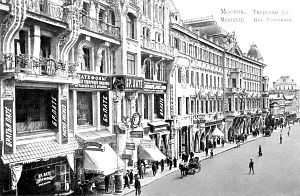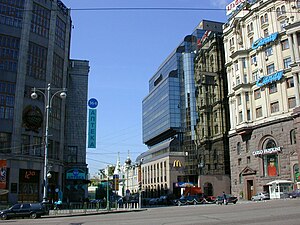This is an old revision of this page, as edited by Truthseeker 85.5 (talk | contribs) at 15:46, 7 August 2006 (some more info). The present address (URL) is a permanent link to this revision, which may differ significantly from the current revision.
Revision as of 15:46, 7 August 2006 by Truthseeker 85.5 (talk | contribs) (some more info)(diff) ← Previous revision | Latest revision (diff) | Newer revision → (diff)



.
Tverskaya Street (Russian: Тверская улица), known as Gorky Street (Russian: улица Горького) between 1935 and 1990 and (unofficially) Piterskaya (Russian: Питерская улица) in the preceding decades, is the main and probably best-known street of Moscow, the capital of Russia. The street runs from the Moscow Kremlin in the direction of Saint Petersburg.
History and architecture
Tourists are told that Tverskaya Street existed as early as the 12th century. Its importance for the medieval city was immense, as it connected Moscow with its chief rival, Tver. At that time, the thoroughfare crossed the Neglinnaya River. The first stone bridge across the Neglinnaya was set up in 1595.
In the 17th and 18th centuries, Tverskaya Street was renowned as the centre of Moscow's social life. The nobility considered it fashionable to settle in this district. Among the Palladian mansions dating from the reign of Catherine the Great are the residence of the mayor of Moscow (1778-82, built up in 1946), the English Club (1780s), and the Eliseev Department Store (1770s, rebuilt in 1790s and 1898).
During the imperial period, the importance of the thoroughfare was highlighted by the fact that it was through this street that the tsars arrived from the Northern capital to their Kremlin residence. Several triumphal arches were constructed to commemorate the coronation ceremonies. In 1792, the Tverskaya Square was laid out before the residence of the governor of Moscow as a staging ground for mass processions and parades. The square's main landmark is the equestrian statue of Yury Dolgoruky, a 12th-century prince who founded Moscow.
During Pushkin's time, the Tverskaya was lined with five churches. The poet wove his variegated impressions from the street into the following stanza of Eugene Onegin:
- The columns of the city gate
- Gleam white; the sleigh, more swift than steady,
- Bumps down Tverskaya Street already.
- Past sentry-boxes now they dash,
- Past shops and lamp-posts, serfs who lash
- Their nags, huts, mansions, monasteries,
- Parks, pharmacies, Bukharans, guards,
- Fat merchants, Cossacks, boulevards,
- Old women, boys with cheeks like cherries,
- Lions on gates with great stone jaws,
- And crosses black with flocks of daws.
Towards the end of the 19th century, the street was reconstructed, with stately Neoclassical mansions giving way to grandiose commercial buildings in an eclectic mixture of historical styles. A characteristic edifice of the time is the Natsional Hotel (1901), whose interior is a landmark of Russian Art Nouveau.
Further expansion occurred at the behest of Stalin in the 1930s, 1940s, and 1950s. During that period, all the churches and most other historic buildings were torn down in order to give way to imposing apartment houses in the typical Stalinist style. The street was widened considerably to resolve the growing traffic concerns. Probably the most architecturally accomplished Soviet building along the street is the Central Post Office (1927-29), a Constructivist masterpiece by Ivan Rerberg.
Layout and functions
Tverskaya Street runs from the Manege Square through the Tverskoy District and the crossing with the Boulevard Ring, known as Pushkin Square, to the Belorussky Railway Station. Its extension, First Tverskaya-Yamskaya Street, continues further north-west right up to Leningradsky Prospekt which keeps the same direction before diverging into Volokolamskoye Shosse and Leningradskoye Shosse (literally, Leningrad Expressway).
Tverskaya Street is the most expensive shopping street in Moscow and Russia. It is the center of the city's nightlife and entertainment.